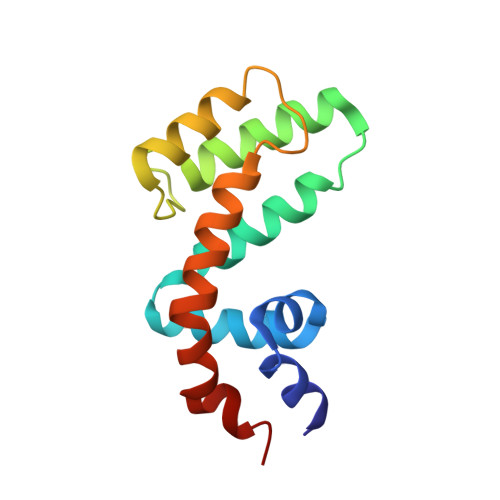14-3-3 protein interacts with and affects the structure of RGS domain of regulator of G protein signaling 3 (RGS3).
Rezabkova, L., Boura, E., Herman, P., Vecer, J., Bourova, L., Sulc, M., Svoboda, P., Obsilova, V., Obsil, T.(2010) J Struct Biol 170: 451-461
- PubMed: 20347994
- DOI: https://doi.org/10.1016/j.jsb.2010.03.009
- Primary Citation of Related Structures:
2OJ4 - PubMed Abstract:
Regulator of G protein signaling (RGS) proteins function as GTPase-activating proteins (GAPs) for the alpha-subunit of heterotrimeric G proteins. Several RGS proteins have been found to interact with 14-3-3 proteins. The 14-3-3 protein binding inhibits the GAP function of RGS proteins presumably by blocking their interaction with G(alpha) subunit. Since RGS proteins interact with G(alpha) subunits through their RGS domains, it is reasonable to assume that the 14-3-3 protein can either sterically occlude the G(alpha) interaction surface of RGS domain and/or change its structure. In this work, we investigated whether the 14-3-3 protein binding affects the structure of RGS3 using the time-resolved tryptophan fluorescence spectroscopy. Two single-tryptophan mutants of RGS3 were used to study conformational changes of RGS3 molecule. Our measurements revealed that the 14-3-3 protein binding induces structural changes in both the N-terminal part and the C-terminal RGS domain of phosphorylated RGS3 molecule. Experiments with the isolated RGS domain of RGS3 suggest that this domain alone can, to some extent, interact with the 14-3-3 protein in a phosphorylation-independent manner. In addition, a crystal structure of the RGS domain of RGS3 was solved at 2.3A resolution. The data obtained from the resolution of the structure of the RGS domain suggest that the 14-3-3 protein-induced conformational change affects the region within the G(alpha)-interacting portion of the RGS domain. This can explain the inhibitory effect of the 14-3-3 protein on GAP activity of RGS3.
Organizational Affiliation:
Department of Physical and Macromolecular Chemistry, Faculty of Science, Charles University in Prague, 12843 Prague, Czech Republic.














